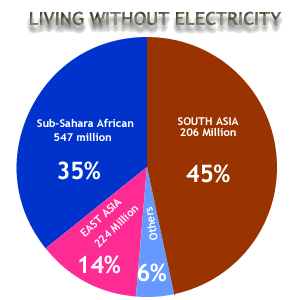A Threat To Humanity...
The Political Divide
The above figure simply depicts the exploitation of natural resources by various countires. More than 206 million of some 1.5 billion odd people of South Asia are still in dark. Lookin as a figure in % this stands at 45%, this indicates how poor the distribution of development.
This tells the "Global North" (the developed country ) who have burned fuel, cut forests to develop their economy have a great onous them. This is what 'Global South' (the less developed nations) stress for in various international forums.
The Rio Summit produced conventions dealing with climate change, biodiversity, forestry, and recommended a list of development practices called ‘Agenda 21’. But it left unresolved considerable differences and difficulties. There was a consensus on combining economic growth with ecological responsibility. This approach to development is commonly known as ‘sustainable development’. The problem however was how exactly this was to be achieved. Some critics have pointed out that Agenda 21 was biased in favour of economic growth rather than ensuring ecological conservation
|
Environmental ActionAlthough environmental concerns have a long history, awareness of the environmental consequences of economic growth acquired an increasingly political character from the 1960s onwards. The Club of Rome, a global think tank, published a book in 1972 entitled Limits to Growth, dramatising the potential depletion of the Earth’s resources against the backdrop of rapidly growing world population. International agencies, including the United Nations Environment Programme (UNEP), began holding international conferences and promoting detailed studies to get a more coordinated and effective response to environmental problems. Since then, the environment has emerged as a significant issue of global politics. The growing focus on environmental issues within the arena of global politics was firmly consolidated at the United Nations Conference on Environment and Development held in Rio de Janeiro, Brazil, in June 1992. This was also called the Earth Summit. The summit was attended by 170 states, thousands of NGOs and many multinational corporations. Five years earlier, the 1987 Brundtland Report, Our Common Future, had warned that traditional patterns of economic growth were not sustainable in the long term, especially in view of the demands of the South for further industrial development. What was obvious at the Rio Summit was that the rich and developed countries of the First World, generally referred to as the ‘global North’ were pursuing a different environmental agenda than the poor and developing countries of the Third World, called the ‘global South’. Whereas the Northern states were concerned with ozone depletion and global warming, the Southern states were anxious to address the relationship between economic development and environmental management. |
Common Responsibility - But Differentiated
The developed countries of the North want to discuss the environmental issue as it stands now and want everyone to be equally responsible for ecological conservation. The developing countries of the South feel that much of the ecological degradation in the world is the product of industrial development undertaken by the developed countries. If they have caused more degradation, they must also take more responsibility for undoing the damage now. Moreover, the developing countries are in the process of industrialisation and they must not be subjected to the same restrictions, which apply to the developed countries. Thus the special needs of the developing countries must be taken into account in the development, application, and interpretation of rules of international environmental law. This argument was accepted in the Rio Declaration at the Earth Summit in 1992 and is called the principle of ‘common but differentiated responsibilities’.
United Nations Framework Convention on Climate Change (UNFCCC)
The 1992 United Nations Framework Convention on Climate Change (UNFCCC) also provides that the parties should act to protect the climate system “on the basis of equity and in accordance with their common but differentiated responsibilities and respective capabilities.” The parties to the Convention agreed that the largest share of historical and current global emissions of greenhouse gases has originated in developed countries. It was also acknowledged that per capita emissions in developing countries are still relatively low. China, India, and other developing countries were, therefore, exempted from the requirements of the Kyoto Protocol. The Kyoto Protocol is an international agreement setting targets for industrialised countries to cut their greenhouse gas emissions. Certain gases like Carbon dioxide, Methane, Hydro-fluoro carbons etc. are considered at least partly responsible for global warming - the rise in global temperature which may have catastrophic consequences for life on Earth. The protocol was agreed to in 1997 in Kyoto in Japan, based on principles set out in UNFCCC.
The year 1998 was the warmest year, probably not only for the 20th century but also for the whole millennium.

